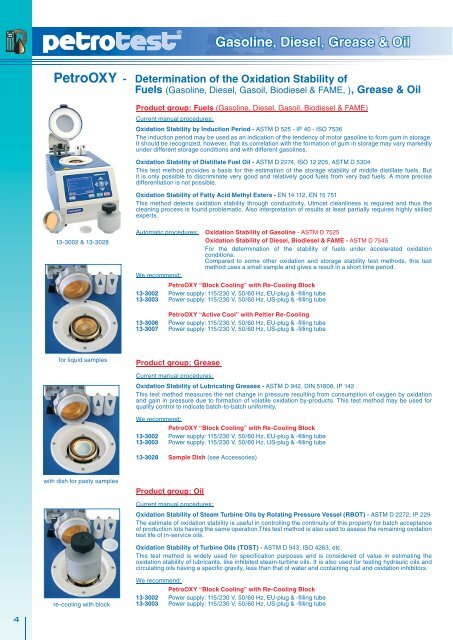Oxidation Stability - TQ Technologies for Quality Srl
Oxidation Stability - TQ Technologies for Quality Srl
Oxidation Stability - TQ Technologies for Quality Srl
You also want an ePaper? Increase the reach of your titles
YUMPU automatically turns print PDFs into web optimized ePapers that Google loves.
4<br />
Gasoline, Diesel, Grease & Oil<br />
PetroOXY - Determination of the <strong>Oxidation</strong> <strong>Stability</strong> of<br />
Fuels (Gasoline, Diesel, Gasoil, Biodiesel & FAME, ), Grease & Oil<br />
13-3002 & 13-3028<br />
<strong>for</strong> liquid samples<br />
with dish <strong>for</strong> pasty samples<br />
re-cooling with block<br />
Product group: Fuels (Gasoline, Diesel, Gasoil, Biodiesel & FAME)<br />
Current manual procedures:<br />
<strong>Oxidation</strong> <strong>Stability</strong> by Induction Period - ASTM D 525 - IP 40 - ISO 7536<br />
The induction period may be used as an indication of the tendency of motor gasoline to <strong>for</strong>m gum in storage.<br />
It should be recognized, however, that its correlation with the <strong>for</strong>mation of gum in storage may vary markedly<br />
under different storage conditions and with different gasolines.<br />
<strong>Oxidation</strong> <strong>Stability</strong> of Distillate Fuel Oil - ASTM D 2274, ISO 12 205, ASTM D 5304<br />
This test method provides a basis <strong>for</strong> the estimation of the storage stability of middle distillate fuels. But<br />
it is only possible to discriminate very good and relatively good fuels from very bad fuels. A more precise<br />
differentiation is not possible.<br />
<strong>Oxidation</strong> <strong>Stability</strong> of Fatty Acid Methyl Esters - EN 14 112, EN 15 751<br />
This method detects oxidation stability through conductivity. Utmost cleanliness is required and thus the<br />
cleaning process is found problematic. Also interpretation of results at least partially requires highly skilled<br />
experts.<br />
Automatic procedures: <strong>Oxidation</strong> <strong>Stability</strong> of Gasoline - ASTM D 7525<br />
<strong>Oxidation</strong> <strong>Stability</strong> of Diesel, Biodiesel & FAME - ASTM D 7545<br />
For the determination of the stability of fuels under accelerated oxidation<br />
conditions.<br />
Compared to some other oxidation and storage stability test methods, this test<br />
method uses a small sample and gives a result in a short time period.<br />
We recommend:<br />
13-3002<br />
13-3003<br />
13-3006<br />
13-3007<br />
PetroOXY “Block Cooling” with Re-Cooling Block<br />
Power supply: 115/230 V, 50/60 Hz, EU-plug & -fi lling tube<br />
Power supply: 115/230 V, 50/60 Hz, US-plug & -fi lling tube<br />
PetroOXY “Active Cool” with Peltier Re-Cooling<br />
Power supply: 115/230 V, 50/60 Hz, EU-plug & -fi lling tube<br />
Power supply: 115/230 V, 50/60 Hz, US-plug & -fi lling tube<br />
Product group: Grease<br />
Current manual procedures:<br />
<strong>Oxidation</strong> <strong>Stability</strong> of Lubricating Greases - ASTM D 942, DIN 51808, IP 142<br />
This test method measures the net change in pressure resulting from consumption of oxygen by oxidation<br />
and gain in pressure due to <strong>for</strong>mation of volatile oxidation by-products. This test method may be used <strong>for</strong><br />
quality control to indicate batch-to-batch uni<strong>for</strong>mity.<br />
We recommend:<br />
13-3002<br />
13-3003<br />
PetroOXY “Block Cooling” with Re-Cooling Block<br />
Power supply: 115/230 V, 50/60 Hz, EU-plug & -fi lling tube<br />
Power supply: 115/230 V, 50/60 Hz, US-plug & -fi lling tube<br />
13-3028 Sample Dish (see Accessories)<br />
Product group: Oil<br />
Current manual procedures:<br />
<strong>Oxidation</strong> <strong>Stability</strong> of Steam Turbine Oils by Rotating Pressure Vessel (RBOT) - ASTM D 2272, IP 229<br />
The estimate of oxidation stability is useful in controlling the continuity of this property <strong>for</strong> batch acceptance<br />
of production lots having the same operation.This test method is also used to assess the remaining oxidation<br />
test life of in-service oils.<br />
<strong>Oxidation</strong> <strong>Stability</strong> of Turbine Oils (TOST) - ASTM D 943, ISO 4263, etc.<br />
This test method is widely used <strong>for</strong> specifi cation purposes and is considered of value in estimating the<br />
oxidation stability of lubricants, like inhibited steam-turbine oils. It is also used <strong>for</strong> testing hydraulic oils and<br />
circulating oils having a specifi c gravity, less than that of water and containing rust and oxidation inhibitors.<br />
We recommend:<br />
13-3002<br />
13-3003<br />
PetroOXY “Block Cooling” with Re-Cooling Block<br />
Power supply: 115/230 V, 50/60 Hz, EU-plug & -fi lling tube<br />
Power supply: 115/230 V, 50/60 Hz, US-plug & -fi lling tube


